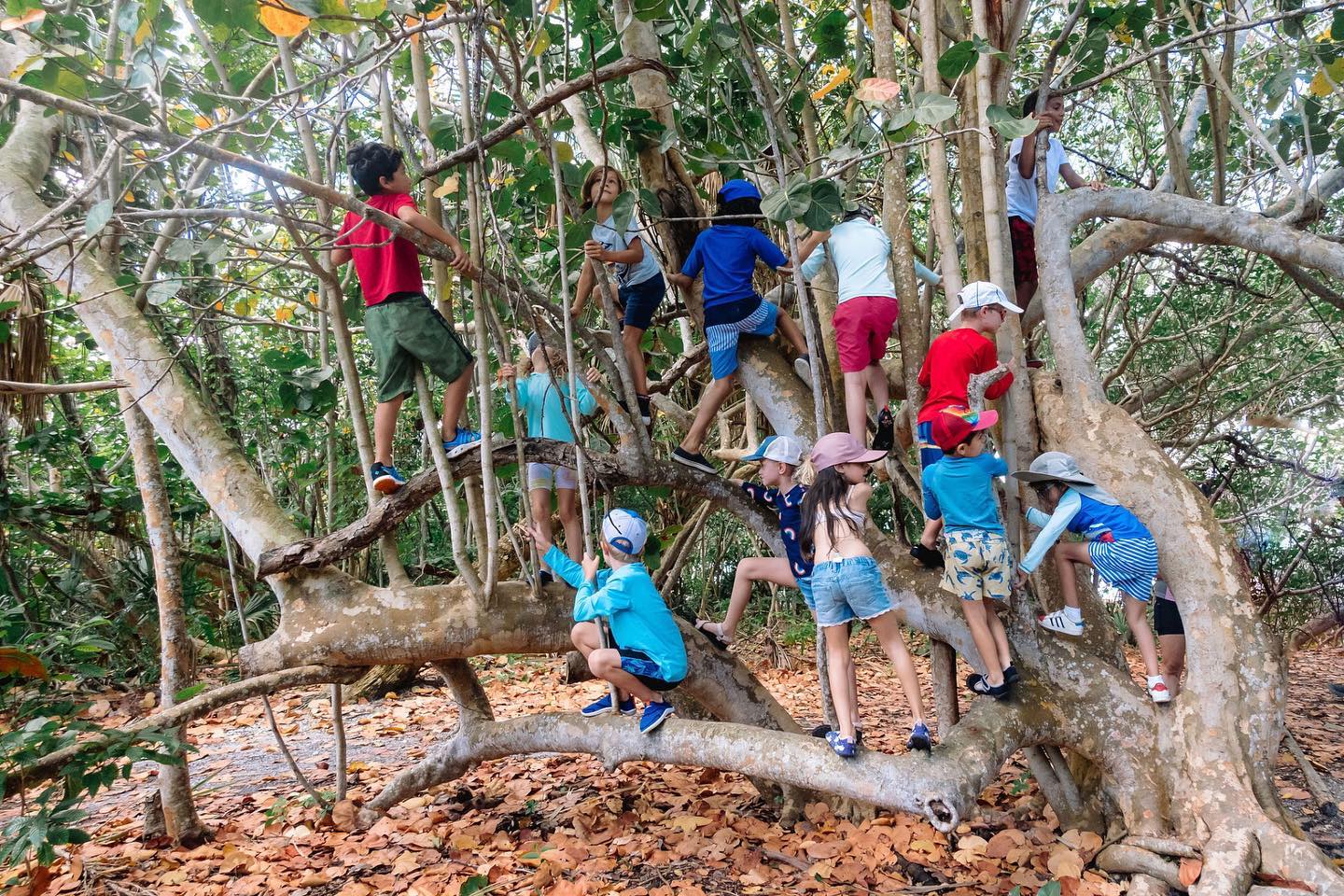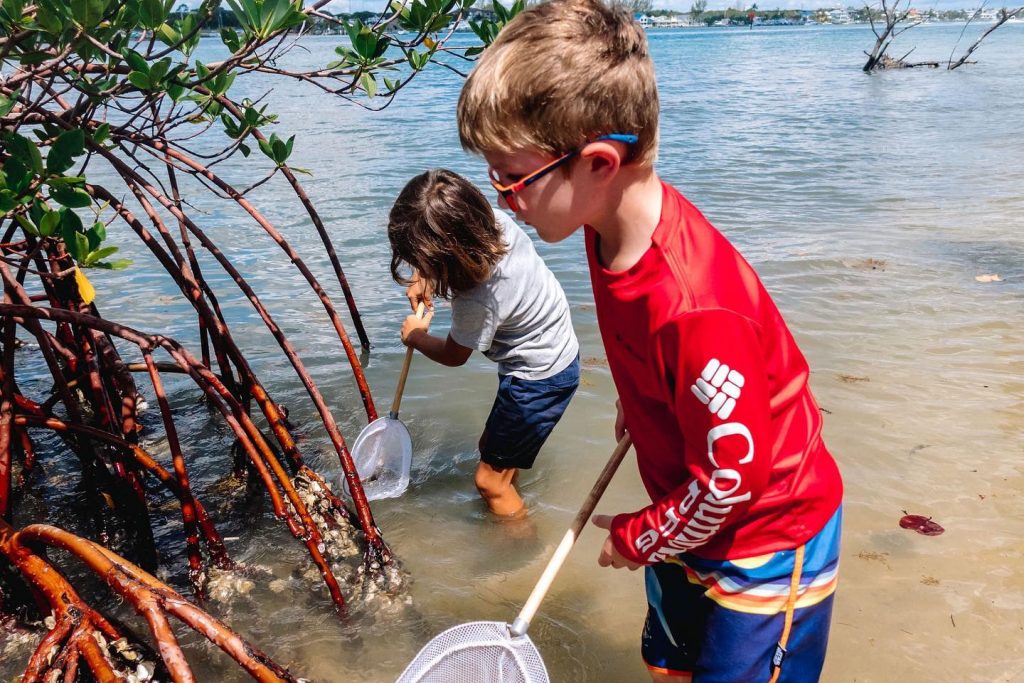
DANIA BEACH, Fla. – While millions of American students sat in rows of desks under fluorescent lights, 40 kids in Take Root Forest School began their day in a state park on the edge of the Atlantic.
Their classroom: Tan sand. Blue water. Sea breeze rustling through cabbage palms. Over the next few hours, the students ages 6 to 12 climbed sea grape, hunted millipedes and, with their bellies on the beach, did their best impression of nesting sea turtles heading back to the surf.
Did your day start off that well?
When you learn outdoors, “you develop an appreciation for where you are,” said Take Root Forest School co-founder Christy Schultz. “You learn the plants. You learn the animals. You learn the subtleties.”
The students “grow to be stewards of where they live,” Schultz continued. “They respect where they live. They know the history. They become more aware of their surroundings, and of other people.”
This way of learning, she said, “transforms people.”
Take Root Forest School would be a sweet story even if it were as rare as a pond apple in what’s left of wild Florida. But as it happens, this humble homeschool enrichment program represents multiple education trends budding at once.

Take Root is a prime example of the growth in outdoor learning and forest schools. It’s a testament to the spike in homeschooling. And it’s another vibrant example of the kinds of nontraditional education providers that are emerging as parental choice re-shapes the landscape.
It also happens to be taking root in Broward and Miami-Dade counties in the shadow of two of the biggest school districts in America, along with a fascinating list of other home-grown innovators like this one and this one and this one.
(For what it’s worth, no big urban district in Florida has seen a bigger jump in homeschooling than Broward; it had 10,412 home schoolers in 2021-22, up 151% over five years.)
For the (Barbados) cherry on top, Take Root’s founders also happen to be former public school teachers, a growing force in education entrepreneurship, especially in choice-rich states like Florida.
“Providing a sense of community was really important to me, but (in a traditional classroom) it was difficult to truly connect,” said Take Root’s other co-founder, Emily Feldman, who taught in public schools for seven years. “I felt disconnected from the students because my time was spent doing other things like grading or testing. I was limited in providing for the child’s individual needs.”
“I left thinking I’d never go back,” Feldman said.
But in a way, Feldman did go back.
On her terms.
She and Schultz both founded their own homeschool enrichment programs before joining forces to create Take Root in 2020. Their enrollment has more than doubled since then, and they now serve about 80 students, with an operation that includes eight teachers.
Their timing turned out to be perfect.
“When Covid hit, we blew up,” Feldman said.
Families wanted their kids to have the social interactions that were stymied by social distancing. Playing and learning outside turned out to be the short-term remedy and, for many families new to homeschooling, a pleasant eye opener about longer-term solutions.
Take Root students routinely meet in local nature parks, like the one where the kids were mimicking sea turtles. They also take more immersive trips to places such as Everglades National Park and Big Cypress National Preserve.
The teachers combine math, science, reading and other traditional subjects with hands-on, place-based activities. The school incorporates elements from Waldorf, Montessori and Reggio Emilia learning systems. And it makes no bones about its environmentalist bent.
Its mission, its website says, is to “provide outdoor learning experiences that inspire the curious mind, instill love and appreciation for nature, and nurture positive and holistic living.”
The result is about more than academics, narrowly defined.
“The students gain confidence,” said Shultz, who taught outdoor education for the state park system in California. “They also have to learn to play together, to cooperate, to work together.”
Jessica Goldman-Ortiz has two children at Take Root: Marco, 9, and Analia, 6.
A former public school teacher, Goldman-Ortiz wanted something different than a traditional school for her children, especially Marco, who was a bit reserved. So, five years ago, she enrolled Marco in Feldman’s program. It was the only pre-school she could find that would allow her to stay with her son until he was comfortable on his own.
Then, once Marco reached that stage, the school was good with him sitting under a nearby tree until he was comfortable enough to join his classmates. It took a few months, but Marco eventually did just that.
“He was given the space and time he needed,” Goldman-Ortiz said. “They’re respectful of the child.”

Parents have the option of sending their kids to Take Root either two or three days a week. A handful pay for academic services affiliated with Take Root using state-funded education savings accounts (ESAs).
Unlike traditional school choice scholarships, which are limited to private school tuition, ESAs can be used for tuition, therapies, tutoring, curriculum, and a wide range of other state-approved uses. Arizona recently made ESAs available to all families, and West Virginia’s new ESA is nearly as expansive. In Florida, they’re limited to students with special needs.
Many Take Root families would qualify for the state’s income-based scholarships (which along with the ESAs are administered by nonprofits like Step Up For Students, which hosts this blog). But those scholarships don’t currently have the flexibility to be used for anything except private school tuition.
If more families could access ESAs, providers like Take Root would become even more popular. Along the way, ESAs would narrow access gaps to educational enrichment that are increasingly drawing attention, as highlighted by this new report from Tyton Partners.
Carolina Graciano said she chose Take Root because traditional schools are not a good fit for her child.
Luciana, 6, was born with a rare genetic disorder called 13q deletion syndrome, which has resulted in some developmental delays. She would have been too isolated in a self-contained special education classroom, Graciano said, but too far behind in an inclusive setting with a traditional focus on academics. Take Root had the balance Graciano wanted.
“When I take her in and drop her off, she says, ‘Okay! Bye!’” said Graciano, a stay-at-home mom whose husband juggles construction work and Uber Eats. “She is happy, and I know that she is learning.”
Beth Arnold said her son, Finnegan, 9, would not have been a good fit with traditional schools, either.
Finnegan is too fidgety for a typical classroom but thrives in environments where he is free to move. At one point, Arnold, a professional writer, enrolled him in a homeschool program that was focused on classical education.
Finnegan wasn’t a fan. But Take Root turned out to be to his liking. Among other upsides, the school frequently meets on the grounds of a historic home that has been converted into a museum. Exotic gardens and a wild monkey are part of the mix.
“It’s magical,” Arnold said.
When she was considering the best options for her son, Arnold said she asked herself: “Do I want him to have a childhood that he loves? Or do I want to prepare him for an Ivy League education?”
“I decided I wanted him to have a childhood that he loves.”



My child went to Take Roots nature seeker program for over 3 years. It was a wonderful experience for us. For me listening to the stories and for my kid learning in a way that seeps into the mind without a struggle. Joyful freedom to explore, ask questions, dream… all in a day. We only stopped going because we moved and we miss it every day.
Hi Nuria! Thank you for taking time out to comment! I heard similarly positive impressions from all the Take Root parents I talked to and wish I could have included more of them in the story. I, too, miss Take Root – and I was only there a couple hours! ???? On the even brighter side, I’m glad more and more parents are able to access the learning options they want for their kids, whether it’s a forest school like Take Root or anything else. The day is coming when all parents can do that.